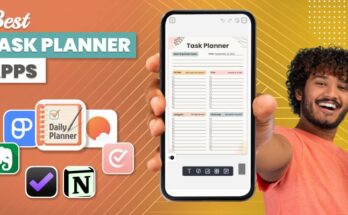In particular, new media sources, like a daily planner app, have made a wonderful change in the efficiency of professional tracking through device-based tools. The new concept of digital planner templates that provide convenience and simplicity is obligatory for increasing efficiency. This blog will focus on the advantages of the use of technology and how it helps to plan your day professionally.
The Importance of Digital Daily Planning for Professionals
Digital daily planning is crucial for boosting productivity, as it helps professionals organize tasks, minimize distractions, and stay focused. By breaking down tasks into manageable steps, planning reduces stress and improves efficiency. Digital daily planner offer added benefits by allowing users to allocate time for both work and personal activities, promoting a healthy work-life balance and enhancing overall job satisfaction.
Enhancing Focus and Clarity
It is quite fundamental to human productivity, to organize the day in advance. By writing down the activities to be accomplished, there can be a better way of avoiding several distractions and hence increase productivity among the professionals. Analog schedulers allow the users to combine the visions of vast tasks into achievable goals and spare no sense during working days.
Balancing Work and Personal Life
Employees do not get a chance to distinguish between the work they are doing and their responsibilities outside work. Digital planners include aspects that users can allocate different segments of time to work, chores, and leisure. This type of organization results in fewer stressful conditions and a higher quality of work-life balance.
Digital vs. Traditional Daily Planner
Explore the key differences between digital and traditional daily planners to determine which best suits your lifestyle and productivity needs.
| Feature | 💻 Digital Daily Planner | 📒 Traditional Daily Planner |
|---|---|---|
| Format | 📲 Digital tools with tech-integrated features. | ✍️ Classic paper-based planners. |
| Connectivity & Syncing | 🌐 Real-time sync, collaboration, and cloud storage. | 📵 Completely offline, with no digital connectivity. |
| Updates & Reminders | 🔔 Instant updates and automated reminders. | 🕰️ Requires manual updates and memory cues; lacks automation. |
| Cost | 💰 Offers both free and paid options, often subscription-based | 💵 One-time purchase, typically more affordable over the long term. |
| Accessibility | 🌍 Flexible and accessible anywhere, but dependent on devices. | 🔋 Always accessible, and battery-free, but it is harder to modify. |
| Customization | 🎨 Customizable UI with options for themes and layout. | ✍️ Simple and intuitive, though requires manual updates. |
| Ideal User Base | 👩💻 Suits multitasking professionals, and remote workers. | 📝 Perfect for low-tech users and those who enjoy the tactile. |
| Popular Sectors | 💼 Highly adopted in corporate, tech, and fast-paced industries. | 🏢 Preferred by traditionalists, minimalists, and smaller businesses. |
| User Suitability | 🚀 Best for tech-savvy, fast-paced professionals. | 🌱 Ideal for those who prefer a tangible, hands-on. |
How Digital Planner Help With Work-Life Balance?
The digital daily planner helps professionals enhance work-life balance by organizing tasks, setting boundaries, scheduling breaks, prioritizing personal time, reducing stress, improving productivity, and ensuring time for both work and personal activities.
Centralized Scheduling
- Unified Calendar: Digital planners make it possible to compare both personal and work timetables to prevent clashes as well as have a way of not failing to consider personal time. Many digital planners also include a drag and drop scheduler, making it easier for users to visually rearrange tasks, adjust priorities, and modify plans without having to rewrite or recreate their schedule.
- Color-Coding: Categories such as work, personal, and family can be arranged with colors, so when organizing the time it’s easier to know which color belongs to work or personal time.
Setting Boundaries
- Time Blocking: People can schedule the blocks of time for the working and personal functions and thus set the time when they are at work.
- Do Not Disturb Features: Some digital planners can be useful to turn off notifications during a personal break so that people do not think about work.
Task Management
- Prioritization of Tasks: Task prioritization is important when Users can complete jobs based on the level of importance so as not to interfere with their personal lives.
- Checklists and Reminders: People should organize their schedules of their official as well as some of the many other life commitments to avoid stress or being reminded at the last minute as this is very bad.
Flexibility and Adaptability
- Real-Time Updates: Some of them can be changed instantly while others can be altered at any time. Then the user can accommodate for any incident that may occur.
- Mobile Access: This is the beauty of using planners; professionals can use them from any device to plan their day and make sense of their time – be it at home or elsewhere.
Integration with Other Tools
- Syncing with Calendar Apps: The digital planners can synchronize with different calendar applications such as Google Calendar or free CRM tools. Therefore, this enables a client to handle diverse demands in one schedule.
- Collaboration Features: Having access to each other’s calendars for members of the families or members of teams enables them to avoid schedule clashes of events and or appointments.
Wellness Tracking
- Incorporating Self-Care: Most planners offer people the ability to schedule time to take care of themselves, exercise, and play, setting gentle prompts to do so.
- Goal Setting: This feature allows users to define personal objectives. Which might include exercise, personal interests, and work objectives so that users’ time is managed with a broader perspective.
Data Insights
- Analyzing Time Use: Some of the digital planners come with built-in features that generate reports on time usage indicating how a particular user may need to shift between work and personal life.
- Reflective Journaling: Aspects that would prompt the consideration of daily achievements should prove helpful to ensure that the users feel a sense of achievement that they need to spend time on themselves.
In this manner, the features incorporated in digital planners help prop up the work-life balance of professionals to improve satisfaction levels and ultimately work productivity.
Top Benefits of Digital Daily Planner App
- Accessibility Anytime, Anywhere: Digital planner app allows users can access their planner via any device that connects to the Internet. There are so many daily planner ideas that boost your productivity. No matter whether you are at work, traveling, or working remotely at home, there is always the planner at your side.
- Multi-Device Access: Multi-media connectivity or multi-tasking of digital schedulers means that the professional can update his plans or refer to the best scheduler for updating at any time in his work or business through his Smartphone, tablet, or laptop.
- Cloud Storage and Backup: Possibly the greatest strength of the PlanWiz digital daily planner app is the use of cloud storage. In addition, while your data is kept safe, you also don’t have to worry about losing key data in case the device you are using gets destroyed or stolen.
- Real-Time Collaboration: Some examples of task-related collaboration include using system calendars or task lists. The fact that they provide updates in real-time, enables everyone to be on pace with the imposes them as effective management tools for projects.
- Sharing Plans with Teams: The exchange of schedules and other to-do lists with other people is made easy through digital planners. Managers can set out assignments, and members can even shift their calendar of events.
- Integrating Feedback and Changes: This way, using the daily planner app, changes provided by colleagues as well as their feedback, are incorporated as an embedded feature. which minimizes disruptions in cooperation.
- Smart Features for Efficiency: Digital planners available on the market. They have features such as auto input of tasks and even suggesting the best time for it in light of the user’s past patterns.
- Task Automation: They disallow users to set up complex general tasks that would not require reprocessing. This makes it possible not to achieve any target or have a deadline or an important date to meet fall by the wayside.
- Integrated Time Management Tools: Most digital planning applications have embedded time management control. Features like time display, productivity analysis, and available prioritizing options.
Customization and Personalization
The best daily planner apps offer customization options, allowing users to personalize layouts, colors, and tasks to suit individual needs, making them more functional and visually appealing. With features like color coding and themes, users can easily organize tasks by time frame. Additionally, integration with popular business apps such as Slack, Trello, and Asana streamlines communication, task management, and scheduling.
Tailoring Planners to Individual Needs
Another advantage of electronic calendars is the flexibility of their design. It is possible to select desirable layouts and colors, as well as the types of tasks that are to be included in the planner. Planners can be personalized to suit the needs of the user and are therefore useful and attractive.
Visual Aids: Color Coding and Themes
To make work easier and chronological. Users can assign colors to the tasks. That enables them to understand the time frame of the task to be completed. These themes make digital planners more appealing and inspiring to use than typical dated and generic layouts. Some digital planners also enable integration with more prominent business apps such as Slack, Trello, Asana, and more.
Environmental Impact of Going Digital
Going digital with planners reduces paper waste, helping conserve trees and minimize the environmental impact of stationery production. Daily planner app promote sustainable practices by encouraging eco-friendly habits in the workplace, reducing the need for paper-based tools, and supporting greener alternatives. This shift toward digital planning contributes to environmental conservation while enhancing efficiency and organization in professional settings.
Reducing Paper Waste
Digital planners eliminate the need for paper, promoting environmental conservation. By reducing paper usage, they help minimize the demand for trees required to produce planners, notepads, and other stationery. This shift to digital planning supports sustainability efforts and contributes to a greener, more eco-friendly approach to organizing tasks and schedules.
Sustainable Practices in Digital Planning
Digital planners raise awareness of sustainability in both companies and individuals, encouraging greener practices in the workplace. They reduce paper waste and promote eco-friendly alternatives. That makes them a better choice for the environment and supports more sustainable work habits.
Conclusion
Daily planner apps are highly useful for today’s business personnel; they provide organization, connective, and ecological value. Using daily planner templates further simplifies scheduling, boosting efficiency. Start today! It also enhances the integration of other applications and other data-based aspects that increase organization and success.








